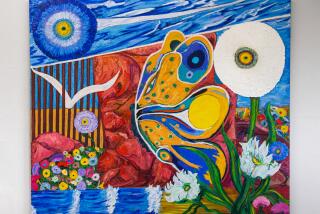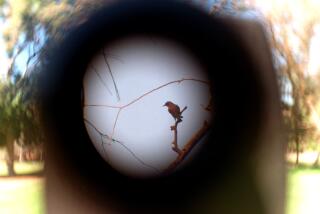Exploring the Spectacular, Colorful World of Butterflies
- Share via
Lepidopterists are changing their spots.
The popular stereotype of the collector in a pith helmet with a butterfly net is rapidly giving way to butterfly watchers, nature enthusiasts who shun the traditional practice of killing things and taking them home to look at.
Times have changed, and binoculars have gotten better. Indeed, lepidopterist Jeffrey Glassberg says the public’s interest in bird-watching coincided with binoculars being made widely available for the first time. Likewise, butterfly watching has benefited from recent advances in the manufacture of close-focus binoculars, which magnify objects 6 feet away and nearer.
“Without binoculars, you can barely see them,” Glassberg says. “With binoculars, they fill your whole field of vision--and look spectacular.”
*
There are many such parallels between the two pursuits. In fact, their interconnectedness is so great that bird- and butterfly-watching guides can often be used interchangeably. Even lepidopterists admit that butterfly watching began as a pastime for bored bird-watchers. Butterflies are most active during the hottest part of the day--late morning and afternoon--when birds are least active.
Butterfly watching as a discipline is still in its infancy.
“There was no such thing as butterflying until we started this organization,” says Glassberg, who founded the North American Butterfly Assn. in 1992. The group, based in Morristown, N.J., has 4,000 members and 30 chapters nationwide.
Glassberg dismisses traditional butterfly guides as “pretty picture books or pictures of dead butterflies.” But a little immodesty may be in order. His own “Butterflies Through Binoculars,” published in 1993, is credited with revolutionizing the pursuit with its emphasis on observation in the field.
Because they favor many of the same things people do, butterflies inflict fewer hardships on their watchers than other similar enthusiasms. They’re late risers. They come out only when the sun is shining. They congregate around flowers. What’s not to like?
Plenty, it turns out. Butterflies can be maddeningly elusive. Although they can usually be found anywhere there’s natural vegetation, some people think they prove the Old World truism about looking for fairies--you find them only when you aren’t looking for them.
They’re also famously ephemeral.
“Butterflies are like wildflowers,” explains lepidopterist Denise Gibbs. “There are seasons for each species. There are things you might see in, say, early April that you won’t see for the rest of the season.”
An average adult butterfly life span is about four weeks, and some species only go through the life cycle once a year. Consider Mitchell’s satyr, active for 10 days in late June. Period.
Butterflies and moths comprise a group of insects called Lepidoptera, a word derived from the Latin ones for “scale” and “wing.” Although scaliness seems a definitively reptilian quality, the markings on butterflies are actually patterns of tiny scales. As for the common name, it is most often said to have derived from England’s yellow Brimstone butterfly--an abbreviation for “butter-colored fly.”
Anyone who paid attention in elementary school science class is familiar with the butterfly life cycle: Butterflies lay eggs that hatch caterpillars. Caterpillars eat voraciously, then their outer layers harden and they enter the chrysalis stage. Inside the chrysalis, the caterpillar is entirely liquefied and reassembled, finally emerging as a butterfly. The adult butterfly devotes its short life to mating. Repeat.
There are 15,000 to 20,000 different butterfly species, about 700 of which can be found in North America (most of them inhabit the tropics). Like other insects, butterflies have a head, thorax, abdomen, two antennae and six legs. Unlike other insects, they have four wings covered with colored scales and a proboscis for drinking nectar and other liquids.
Some lepidopterists joke that butterflies are “solar-powered.” Butterflies are coldblooded, and they can’t fly if they’re not warm enough, which is why they don’t appear until temperatures are at least in the 50s. There are relatively few butterflies in the Pacific Northwest because of the area’s rain and fog, and more in sun-baked Texas than anywhere else in the United States.
Far from being simply ornamental, butterflies display the same range of behaviors as other wildlife. “They have courting behaviors just like any other animal,” she explained. “Mating behaviors, territorial behaviors . . . they’ll stake off a patch and protect it.”
*
The more detailed an observer’s knowledge of butterfly behavior, the easier the insects are to locate and identify. Hard-core experts make very fine distinctions, such as between caterpillar-chewed and beetle-chewed leaves. Sometimes noting behavioral nuances is the only way to differentiate among similar species.
Since the insects spend so much of their time feeding, knowledge of plants is often synonymous with knowledge of butterflies. But many plants that nourish caterpillars and butterflies, such as Queen Anne’s lace, goldenrod and dandelions, are considered weeds. That’s part of the reason butterflies appear in some of the places they do: on roadsides and and vacant lots.
But they’re not purists--they also show up at garden stores. Lisa Bierer-Garrett, a naturalist at Clearwater Nature Center in Clinton, Md., relishes the fact that they’re apt to turn up anywhere. Or almost anywhere.
“Any place that has flowers,” she says.
(BEGIN TEXT OF INFOBOX / INFOGRAPHIC)
What to Plant So Your Garden Takes Wing
Butterflies are that rarity: the insect that people actually want to attract. So increasingly, people are taking up “butterfly gardening,” planting the insects’ favorite flowers in hopes of luring them.
Prospective gardeners don’t lack for guidance. There are numerous Web sites (the Butterfly Zone at https://www.butterflies.com is a good start) and books (the most venerable is “Butterfly Gardening: Creating Summer Magic in Your Garden,” co-written by the Xerces Society and the Smithsonian Institution, Sierra Club Books, $24).
To be truly effective, butterfly gardens must provide for the creatures at every stage of the life cycle. So there must be food plants for growing caterpillars (alfalfa, anise, dill, parsley or milkweed, for example) as well as nectar plants for adult butterflies (some favorites are verbena, zinnias, marigolds, sweet William, phlox, impatiens, heliotrope, larkspur, black-eyed Susan, lavender, dandelions, honeysuckle, coneflowers and morning glory). A bonus: Many of these plants also attract hummingbirds.
Window boxes in first- and second-story windows, no more than about 15 feet from the ground, can serve the same purpose.
Some things to remember:
* Don’t use pesticides.
* Plant in direct sunlight; butterflies rarely feed in the shade.
* Plant near a windbreak. If there’s no natural windbreak, create one with fencing or shrubs.
* Nectar plants should be of varying heights.
* Plant wild and cultivated flowers.
* Large masses of a few varieties of flowers are preferable to small patches of many varieties.
* Provide a mud puddle or fill a birdbath with moist sand.
* Include flat rocks for sunning.
* Choose flowers with care; butterflies cannot gather nectar from deep-throated flowers.
* Plant brightly colored flowers. And make sure the things you plant span the entire season, from spring through fall.
* If you like the idea of attracting butterflies but dislike gardening, you can make a butterfly feeder by putting a slice of watermelon or a rotten banana in a shallow dish and hanging it from a tree. (Some people achieve the desired level of banana deterioration by peeling them, putting them in the freezer for a while, then thawing them.)
(BEGIN TEXT OF INFOBOX / INFOGRAPHIC)
For More Information
The North American Butterfly Assn. Web site, which includes membership information, a list of local chapters and a wealth of butterfly arcana, is at https://www.naba.org.
Suggested reading:
* “Handbook for Butterfly Watchers,” by Robert Michael Pyle. Houghton Mifflin Co., 1984, $14.
* “How to Spot Butterflies,” by Patricia Taylor Sutton and Clay Sutton. Houghton Mifflin Co., 1999, $17.
More to Read
Sign up for The Wild
We’ll help you find the best places to hike, bike and run, as well as the perfect silent spots for meditation and yoga.
You may occasionally receive promotional content from the Los Angeles Times.






